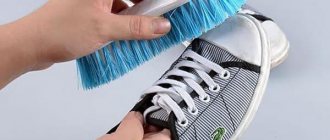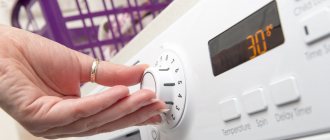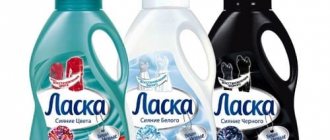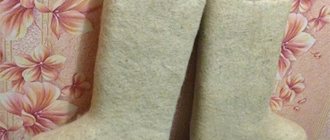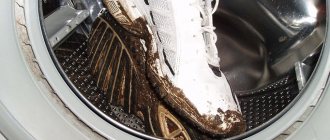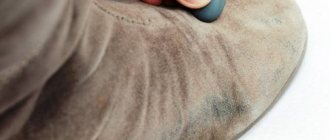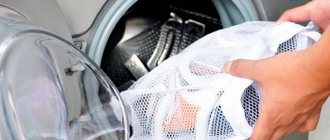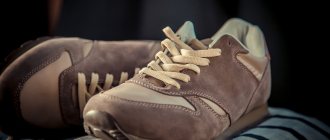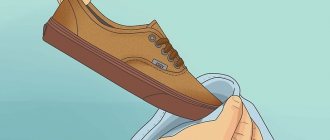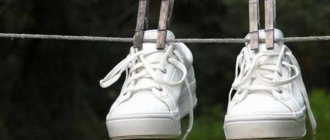Is it possible to wet felt shoes?
It is better to clean felt boots using a dry method. But in case of severe pollution, you cannot do without water. You can wet your shoes by following the rules:
- Carpet cleaner can handle fresh stains. Lather the product in warm water, apply to the stain and rinse off after a while.
- Greasy areas are tidied up with starch or flour. Pour the powder onto the problem area and brush off after a few minutes.
- In winter, white salt stains appear on shoes. To remove them, the pressure of clean tap water will be enough.
Drying Kuoma felt boots
After cleaning the boots from dirt, you need to put them in a basin and let the water drain. Unlike ordinary felt boots, water drains from Kuom very quickly and the drying process will not last long. You can immediately fill the felt boots with dry paper. This will help maintain its shape and quickly get rid of excess moisture. After the excess water has gone, you should move the shoes to a dry, warm place.
Do not place it on or near heating appliances. The temperature of warm air should not exceed 40 degrees.
After washing, you can lubricate your shoes with special products that restore the protective properties of the shoes. If desired, they can be found in stores. It is recommended to wash Kuoma felt boots once a season. For minor stains, simply wipe them with a damp sponge.
Many experts recommend opting for hand washing. This will not take much time, but will keep the product looking more attractive. By applying simple rules for caring for felt boots in everyday life, you can provide your feet not only with comfort and warmth on harsh frosty days, but also with beauty.
How to wash felt boots at home
If the shoes are very dirty, dry cleaning will not help. Before washing your felt boots, you need to read the information on the label. It should have a “washing allowed” icon and its conditions.
In the washing machine
If the label doesn't say anything about machine washing, then it's not worth the risk.
It is also better to protect high felt boots from automatic washing - they can wrinkle.
For other cases, the machine wash settings are as follows:
- delicate mode;
- low water temperature;
- no spin.
Manually
If shoes cannot be washed in a machine, hand washing will come to the rescue.
- Fill a basin with warm water.
- Add grated laundry soap.
- Immerse the boots in water until they are completely wet.
- For severe contamination, wait 10 minutes.
- Treat problem areas with a sponge or soft brush.
- Rinse with clean water and squeeze lightly.
- When the water has drained, give the product the correct shape.
- Pack old newspapers tightly inside.
- Leave to dry in a warm room, but not near the radiator.
Features of caring for products of different colors
It used to be that felt boots all looked the same: gray, brown, black. Today, artists have taken on these shoes. And their “brainchildren” are simply beautiful.
White
White felt boots are the most popular and most problematic category in terms of cleaning. You can use a vacuum cleaner to remove dust and small debris from them. For sand, soil residues and dried dirt, the best remedy is a brush with rubber or rubber teeth.
“Laska” works well on light-colored models. Designed for the care of delicate materials. Ensures color preservation.
The composition must be diluted in cold water. For greater whiteness, add bleach (not containing chlorine). Apply to the felt surface and walk over the problem area with a sponge. Let the shoes dry.
Dark and gray
These are the most practical options. They show almost no light dirt. But, nevertheless, such felt boots also have to be cleaned. Dry methods provide a more gentle treatment of the material.
Contaminated felt boots are first dried. Dried dirt is removed using a crust of dry bread. Crumbs are removed with a brush. Dark models can be cleaned with soap suds. To remove the foam itself, use a damp cloth. Dry in a warm room.
If artificial fibers are added to the wool, the area of contamination is treated with soap. Just first the area of the stain needs to be slightly moistened. At the end, use cold running water to rinse. The composition of the felt can be found on the product tag.
Colored with decorative elements
Shoes with decor require special care. Felt boots can be decorated with pieces of leather and fur, rhinestones, beads, patterns, and embroidery. Wet cleaning of such stylish and original shoes can lead to shedding of the decor and staining of the light felt. Therefore, it is better to clean such shoes using dry methods. Apply the product strictly to the problem area. If the decoration is sewn on, you will have to tear it off and, after cleaning, sew it back in its original place.
Is it possible to wash Kuoma felt boots?
Finnish Kuoma felt boots only superficially resemble Russian national shoes. The Finnish version has rubber inserts, super durable soles, natural sheepskin insoles, and faux fur interior trim.
For cleaning it is recommended:
- use a damp cloth;
- wash at 40 degrees;
- replace powders with liquid soap;
- Place laundry balls or tennis balls into the washing machine along with the product.
To restore the water-repellent impregnation, spray a special aerosol on the felt after washing.
Drying felt boots after washing
Properly dried shoes will retain their appearance much better than those left to dry haphazardly. When wet and washed, felt boots can become deformed under the influence of rotation in the drum of the washing machine. After removing from the machine, you need to lightly press the felt to squeeze out excess water without deforming the shoes.
The felt is very tightly knit; it takes patience to remove water from it. After washing, you need to put the product in a basin and let the water drain for a while. Then remove and move to a dry, warm place. Some people advise stuffing felt boots with paper, but it is better not to do this immediately after washing. It is necessary to prepare cotton fabric scraps and fill the felt boot block to maintain the shape.
If you immediately stuff it with paper, it will take on too much moisture, which will make it difficult to remove it from the outside. The paper will tear easily and wet pieces will remain inside. You can use the paper after a while, when the first moisture is absorbed into the cotton fabric. To make the procedure easier, you can stuff your felt boots with plastic bags and set them to dry.
If after washing some area of the felt is not washed off or an unpleasant odor remains, it is better not to resort to re-washing the shoes. Repeated washing will quickly deteriorate the condition of your shoes. The remaining stains can be removed manually using special products. The unpleasant smell of shoes can be removed by carefully treating them with a cotton swab dipped in vinegar essence.
Additional recommendations
Washing socks should not be taken lightly. This part of the wardrobe carries a large number of bacteria, and in addition, wears out quickly
To avoid spreading germs to other clothes and to extend their lifespan, it is important to mix and dry socks correctly
What you can wash with and what you can’t wash with
For hygiene reasons, it is not recommended to combine socks with underwear. You should also wash separately from clothes with Velcro or hooks, which may leave snags or tear the material. The couples will be accompanied by jeans, stockings, and tights.
If you have nail fungus, wash your socks by hand separately from other clothes. It is recommended to soak your socks every evening before the main wash in water with vinegar, hydrogen peroxide or chlorhexidine.
Drying rules
After washing, the socks should be hung on the dryer and left to dry at room temperature. It is convenient to use a hanging dryer with clothespins. It saves space and dries vapors without kinks.
Drying on a radiator or heated towel rail is not recommended, especially if the socks are made of synthetics. This will lead to shrinkage of the products. Woolen pairs are dried only in a horizontal position away from heating appliances.
To wash socks, you need to follow simple rules: turn them inside out, put them in an automatic washing bag, and use liquid detergents. Dirt will be washed off easier if you pre-soak the items in cool water.
Take additional measures
There are a few additional steps you can take to maximize your chances of fending off coronavirus when you wash your clothes.
Extreme and freezing temperatures can prevent bacteria from growing, so if you wash your laundry in a machine, take the extra step of placing your washed items in the dryer for 20 minutes for extra heat and germ-killing. Do not forget to add 200 ml of 9% table vinegar to the conditioner tray during rinse mode. For those items that are too delicate for a very hot wash, consider chemical treatment for a thorough clean.
What shoe models to avoid
When choosing winter shoes, you should be guided not only by their attractive appearance, but also by the safety of walking in them. Particular attention should be paid to the soles of shoes and boots. It’s definitely not worth saving on your purchase. It is advisable to purchase high-quality safety shoes from manufacturers in those regions where severe frosts occur: Russia, Canada, Scandinavian countries.
In shoes with thick soles and a tread with deep, uniform relief, the risk of slipping is much less. Corrugation serves the same role as the tread pattern on winter car tires. It is desirable that the elements are directed in different directions. The thickness of the sole should be at least 1 centimeter.
You should not choose shoes:
- on a high platform;
- having a thin high heel;
- having a small area of contact with the road surface;
- with a smooth sole;
- with pointed toes;
- with plastic heel.
The safest winter boots and boots have solid soles. If there is a heel, special requirements are placed on it. It shouldn’t be tall, but it should be wide and stable. The material of manufacture plays an important role. Optimal solutions: thermoplastic elastomer, thermopolyurethane, rubber. The choice for small restless children requires special attention.
The most basic rule is that all these requirements should not affect the comfort of the products when using them. During fitting, it is recommended to walk in shoes, preferably on tiles. If your feet slip and move apart in your new clothes, this will serve as a warning signal.
On a high platform
Stiletto heels
Shoes with a small area of contact with the road surface
With smooth sole
Pointed toes
With plastic heel
Remove stains and dirt
Contaminants should not be removed in a wet state. Because in this case you will only be able to smear them, and not remove them permanently. It is worth drying the product and then proceeding with the cleaning procedure. Large pieces can be removed by hand; do not use a knife or sandpaper for this, as this will damage the surface of the product. It is better to buy a suede brush with rubber bristles from a shoe store.
We also recommend reading: How to smooth the leather on a jacket, how to smooth a leatherette jacket
To remove stains, you should not use an acid solution (acetic or citric), since on dark products it will leave a light area and can spoil the material, and light ones will begin to turn yellow in this place. It is worthwhile to carefully approach the issue of cleaning this type of shoe in order to wear it for more than one season.
Most of the dirt can be easily removed with a soap solution, or you can resort to heavier artillery - remove dirt with products for washing delicate fabrics and cleaning carpets. They will not damage the material, but will effectively cope with heavy stains. It is also recommended to use a solution of washing powder not locally on stains, but entirely on the entire product, since otherwise there may be areas of lighter color at the site of former contamination.
What can't you do?
Here is a list of actions that should not be done:
- Dry in direct sun, on a radiator, on a heater; they will shrink from direct contact with heat. This will happen even if you stuff them with rags or paper.
- You can’t leave them undried after coming home. Be sure to clear the snow, stuff the felt boots with newspaper to give them shape, and place them in a well-ventilated, warm place.
This material is good at remembering shape; if you leave them wet, they will become deformed. But returning them to their original appearance is not an easy task.
- Start washing without first removing pieces of dirt, as it will penetrate into the fibers.
- Wear them in rainy weather.
Washing with shampoo
A small fleece can be cleaned of dust and dirt using a colander. After all, excessive touching of the fibers provokes destruction of their structure. Therefore, it is strictly forbidden to squeeze and wash the raw meat with your hands.
When using shampoo, proceed as follows:
- Fill a basin with hot water and add shampoo to it. Variations are preferable for oily hair, as well as for bathing animals. Stir well until foam forms.
- Dip the combed and sorted wool into the foam solution and leave for 30 minutes.
- Drain the contents of the bowl into a colander.
- Repeat the procedure 5-6 times.
- Soak the raw materials in clean hot water and leave for 2 hours.
- Using a colander, drain the dirty water and rinse the wool.
- It is strictly forbidden to squeeze the fleece with your hands. Place it on a mesh and let the water drain.
Important! When drying, the sheep's wool is spread out in a thin layer. Its thickness should not exceed 1.5 cm
Otherwise, the material will fall off.
Special devices
The solution to the problem of what to do to prevent shoes from slipping in winter is to use special devices. You can purchase them or create them yourself using materials available in the house. Lifehacks will help you add anti-slip elements to your shoes.
Stickers
The materials used to make anti-slip stickers are polyurethane or vulcanized rubber. You can buy them in the shoe department. Stickers on the sole are selected taking into account the size of the shoe:
- the first is for boots or boots of size 35-38;
- the second - for 39-41;
- the third – starting from 42 and above.
Self-adhesive overlays can be used not only for flat soles, but also for models with heels. Before gluing, you should clean the sole from dirt and degrease it. The effect of the application is that it provides protection against slipping on ice in winter. They are also a preventive measure against rubbing. Can be used from several days to a month.
Anti-slip stickers
Before gluing, clean the sole from dirt and degrease it.
Use for flat and heeled shoes
Ice access
Anti-slip pads on shoes are common devices that protect against falls. Ice access shoes are a special design that can be attached to boots of any size. The shoe device is made of very high quality rubber into which steel spikes are inserted. This provides excellent grip on icy surfaces. Different types differ in a number of ways: material of manufacture, method of fixation, number of spikes. The best are steel ice access platforms, which have increased resistance to loads.
The products are removable, which allows you to use them only when necessary. Fixed on the sole, they are almost invisible from above. Such anti-slip shoe attachments have the following advantages:
- increased frost resistance - up to -40 ° C;
- versatility – there are sizes suitable for children and wide men’s feet;
- compactness - they can be easily packed into a bag;
- durability, allowing them to be used for several seasons in a row;
- ease of putting on and taking off;
- aesthetics;
- low cost.
A relative disadvantage is that they are not suitable for indoor movement. Therefore, you have to take them off when entering from the street. When walking on tiles or marble, they make a loud sound.
General rules of care
It is recommended to refresh your white felt boots after each time you wear them outside. It is necessary to clean them from dirt immediately after returning from a walk:
- From felt boots, without waiting for them to melt in the heat, use a medium-hard brush to clear snow and ice. It is impossible to allow snow to melt directly on shoes, since felt is prone to shrinkage and after drying, the shoe size will become significantly smaller.
- If shoes are damp, they should not be placed near heating appliances to dry. The inside of each felt boot is stuffed with paper and the shoes are dried at room temperature.
- After clearing the snow, the felt boots are dried. The dirt is removed with a stiff brush after drying.
Following all recommendations for cleaning shoes will help restore a fresh, neat look. But it is recommended to entrust expensive designer felt boots to dry cleaning professionals.
Cleaning methods
You can clean felt boots using dry and wet methods using industrial products, as well as folk methods.
Folk
Available products suitable for dry cleaning can be found in any home. They effectively clean the surface of felt and do not have a harmful effect on its structure.
Traditional methods are mainly used to remove minor contaminants:
- You can refresh the white color with dry semolina. The cereal is evenly distributed over the surface and lightly beaten in. After 15-20 minutes, the semolina absorbs dirt and is cleaned off with a brush. The same cleaning method is possible using starch, soda, and tooth powder.
- Flour will help remove fresh dirt from the felt. They sprinkle it on their shoes immediately after returning home, without waiting for the dirt to dry. After 15-20 minutes, the flour is cleaned off and the pile is combed.
- You can remove dirt from the surface with fine-grained pumice. Lightly wipe the felt with it, and then comb it with a soft brush.
- Table salt is a good tool for knocking dust out of piles. Salt is poured evenly onto the surface, then cleaned with a damp brush.
- Clean snow effectively removes dirt from fur. On a frosty day, they put felt boots on their feet and climb into a snowdrift away from the roadway. After this procedure, the snow and dirt are removed from the surface with a brush.
Professional
To care for the fleecy surface of felt, use a special brush with rubberized teeth, specialized cleaning products and water-repellent aerosols.
Professional formulations and household chemicals help in the fight against severe pollution:
- Saphir Omni Nettoyant – shampoo for cleaning shoes made of nubuck, suede, textiles, felt. The product is diluted with water 1:2, and then applied to felt boots with the brush included in the kit. The solution is foamed on the surface, then washed off with clean water.
- Salton is a universal foam cleaner with an improved formula. It has a cleansing and at the same time protective water-repellent property. The foam is applied to the surface of the shoe, then cleaned off.
- Vanish carpet cleaner or regular shampoo. A small amount of the substance is whipped into foam, applied to the surface with a thick sponge or brush, and left until completely dry. After the foam has dried, lightly rub the surface with a dry brush. Then the surface is treated with a vacuum cleaner.
- You can clean the surface with a solution of washing powder or liquid detergent ( Laska , Help ). They are diluted with water and applied to felted boots with a brush. Then the surface is treated several times with clean water using the same brush.
Collonil Nanopro , Salamander , Akvabron , Olvist , etc.) before each trip outside, Felt boots without soles can only be used in urban environments with special protective galoshes.
You might also be interested to know: how to wash ugg boots
Removing stains
If dark spots appear on felt boots, they are removed using the following means:
- Soda and vinegar . A tablespoon of soda and the same amount of washing powder are diluted in hot water. Then add 4 tablespoons of 9% vinegar to the solution. The mixture is applied to the stain until the reaction is complete. At the end of the reaction, the mixture is removed with a damp brush.
- A stubborn stain can be washed with a solution of soap and turpentine . A tablespoon of grated laundry soap is mixed with 500 ml of warm water, and a tablespoon of turpentine is added. The mixture is applied to the entire surface of the felt boots so that there are no streaks left. After 10-15 minutes, the cleaning mixture is removed with a damp brush.

